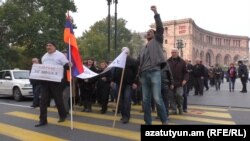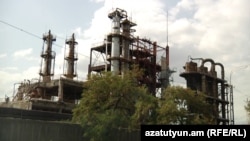An Armenian court last week declared the state-owned Nairit synthetic rubber plant bankrupt in response to a request by the national power utility Electricity Networks of Armenia, which is owed some 1.24 billion drams ($2.6 million) in unpaid electricity bills by Nairit's management.
The ruling on the shuttered Yerevan plant, a former economic flagship seen by some as having the potential to return to profitability and retain local jobs, was unexpected for several reasons.
Eighteen months ago, then-Energy Minister Yervand Zakharian had told the Armenian parliament that even though a World Bank audit indicated that reviving the plant was not economically viable, the financial expenditure that bankruptcy would entail would be far higher. He said it was "absolutely not true" that the government "is taking the company to dissolution."
Just a few months ago, Nairit’s management concluded new employment contracts with some 250 employees, even though the plant has stood idle since April 2010, while the Armenian government had announced a tender, which expires only in January 2017, for potential investors to present their proposals for reviving production. As recently as October 2016, an Armenian-born businessman from Slovakia, Ashot Grigorian, said that he and other Slovak entrepreneurs were willing to invest $100 million in reviving the plant if the Armenian government transferred ownership to them for free.
But Karen Karapetian, who succeeded Hovik Abrahamian as Armenian prime minister in mid-September, expressed doubts at the long-term viability of proposals made by potential investors who, he said, had not factored in the possibility of a substantial rise in energy prices.
The decline of Nairit is symbolic of the economic stagnation, murky business deals, and defiant grassroots activism that Armenia has experienced over the past three decades.
In 1987, when Soviet leader Mikhail Gorbachev's policy of "glasnost" (openness) made possible the public discussion of hitherto taboo issues, the Armenian intelligentsia began to call for the plant's closure on the grounds that the emissions it produced were harmful to human health.
That demand was swiftly eclipsed by the mass campaign for the transfer of the Nagorno-Karabakh Autonomous Oblast from Azerbaijani to Armenian jurisdiction. But Nairit was forced to close temporarily in the early 1990s due to the economic collapse triggered by the demise of the Soviet Union. The plant then changed hands several times before an obscure British company, Rhinoville Property Ltd., purchased a 90 percent stake in Nairit for $40 million in 2006, using a $70 million loan from the Commonwealth of Independent States (CIS) Inter-State Bank. Rhinoville then failed, however, to make good on its promises to modernize the plant and raise employees' salaries. The plant suspended production from December 2008 to April 2009 after demand plummeted in the wake of the global financial crisis and then definitively halted operations in 2010.
In January 2014, the Moscow Arbitration Court awarded Rhinoville's 90 percent stake in Nairit to the CIS Inter-State Bank due to nonrepayment of the original loan. The following year, the bank wrote off the debt and transferred those shares to the Armenian government. Also in early 2014, former Armenian Prime Minister Tigran Sarkisian announced after meeting with Rosneft head Igor Sechin that Rosneft was considering investing $500 million in Nairit. No concrete agreement was ever forthcoming, however.
In early 2015, at the request of the Armenian government, the World Bank conducted an audit of Nairit, on the basis of which it advised against relaunching production. It estimated the cost of doing so at $250 million and warned that due to high production costs the finished product would not be competitive on the world market.
Hrach Tatevosian, who heads the Nairit employees' trade union, challenged that argument, telling the news portal Caucasus Knot that the plant's specialists had drafted three separate programs for renewing production of various quantities of rubber. The most expensive of these three variants, he said, would require just $97 million in new investment.
Former Nairit Director Karen Israelian came up with an even lower figure. He estimated $10-15 million would be adequate to resume annual production of 10,000 to 12,000 tons of rubber. He admitted that Japanese-produced rubber is of higher quality, but predicted Nairit's output would find a ready market in Russia.
Meanwhile, Nairit's remaining workforce, together with some 1,700 employees laid off in early 2015, has fought for years for full payment of wage arrears going back to 2010, staging repeated demonstrations and sit-ins outside the government building and the presidential palace. In August 2015, by which time the arrears had amounted to some $10 million, they were finally paid off in full. But within a month they had resumed their demonstrations, this time to demand that Nairit resume production.
In March 2016, Zakharian's successor as energy minister, Levon Eolian, set up a commission that included five former Nairit employees, to evaluate the possibilities of reviving the plant. Nairit's lawyer, Armen Abovian, could offer no explanation why the court brought the date for declaring the plant bankrupt forward, to late November, given that the tender for investors to propose a new business plan expires only in January 2017. RFE/RL's Armenian Service quotes embittered former employees as saying they suspect the government was simply unwilling, for whatever reasons, to save Nairit.

